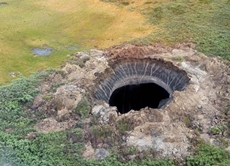Global warming likely cause of Siberia’s mystery craters
07 Jan 2016
Russian scientists have now discovered seven giant craters in remote Siberia, and the mysterious phenomenon is believed to be linked to climate change.
 | |
| Image: earthsky.org |
The discovery of an enormous chasm in a far northern region known to locals as ''the end of the world'' in July last year prompted speculation it had been caused by a meteorite or even aliens.
A YouTube video of the hole went viral and a group of scientists was dispatched to investigate.
''We have just learnt that in Yakutia, new information has emerged about a giant crater 1km in diameter,'' the deputy director of the Oil and Gas Research Institute of the Russian Academy of Sciences, Vasily Bogoyavlensky, told AFP.
He said this brought to seven the number of reported pits.
''Footage allows us to identify minimum seven craters, but in fact there are plenty more,'' he said.
All of the craters have been discovered in the remote, energy-rich Yamalo-Nenetsky region in north-western Siberia.
Earlier theories about the mystery craters have variously attributed them to meteorite impacts, missile strikes, explosions from nearby gas fields, and the melting of soil-covered ice mounds, known as pingos. The most likely explanation for the phenomenon, however, seems to be climate change.
Scientists say that rather than aliens or meteorites, the holes are caused by the melting of underground ice in the permafrost, which has possibly been sped up by rising temperatures due to global warming.
''The phenomenon is similar to the eruption of a volcano,'' said Bogoyavlensky.
As the ice melts, methane gas is released, which builds up pressure until an explosion takes place, leading to the formation of a crater.
Whether or not they end in explosions, these methane releases are a serious concern. Methane is a greenhouse gas, and on a molecule-by-molecule basis it is a far more potent warming agent than carbon dioxide (although it doesn't last as long in the atmosphere). If the permafrost is leaking methane because of rising temperatures, a positive-feedback loop could be taking effect: more methane leads to further warming, which leads to further thawing, and so on.
The scientists are still trying to estimate what danger, if any, is posed by the holes. Methane is extremely flammable and at least one of the craters is situated near an exploited gas deposit.
Man-made earthquakes
The holes in Siberia also point to another, stranger phenomenon. Global warming and geology turn out to be connected in unexpected ways. Consider, for example, earthquakes. Generally, earthquakes occur because of the movements of Earth's tectonic plates; they tend to take place along plate boundaries. But recently Greenland has been experiencing an unusually large number of quakes. One widely discussed theory attributes this to the shrinking of the Greenland ice sheet. As the ice sheet melts, its weight declines, allowing the land underneath it to rise. The process, which is known as isostatic rebound, may well be responsible for the increase in seismic activity.
Iceland, too, is rising, and for similar reasons. As the country's glaciers melt, the land is rebounding. A recent study showed that some parts of the country are gaining elevation at the astonishing rate of 1.4 inches a year.
''What we're observing is a climatically induced change in the earth's surface,'' Richard Bennett, one of the authors of the study and a geoscientist at the University of Arizona, told the website Live Science last month. In the case of Iceland, that change may lead to an increase in volcanic activity. As the land rises, the pressure on the rock beneath it changes. Lower pressure translates into a lower melting temperature, which could, in turn, translate into more (or at least more destructive) volcanic eruptions.
The past five years have been packed with ''interesting volcanic activity,'' Sigrún Hreinsdóttir, Bennett's fellow-researcher and a geophysicist at the University of Iceland, told the Washington Post. ''You can't make any statistics from those few data points, of course, but you do notice there might be a connection with the uplift.''
And there's a precedent: during the deglaciation that occurred at the end of the last ice age, some twelve thousand years ago, volcanic activity in Iceland is estimated to have increased by as much as a factor of thirty.
An expedition is planned to the latest crater discovered to determine if it was formed in the same manner.
It may be hard to identify other craters which may have formed into lakes over time, said Bogoyavlensky.
''When they appear the craters are empty, and little by little they fill up with water. In the space of two or three years they become lakes and it is difficult to study them.''
He said some may have formed dozens or hundreds of years ago, but went unnoticed in such remote regions.






























